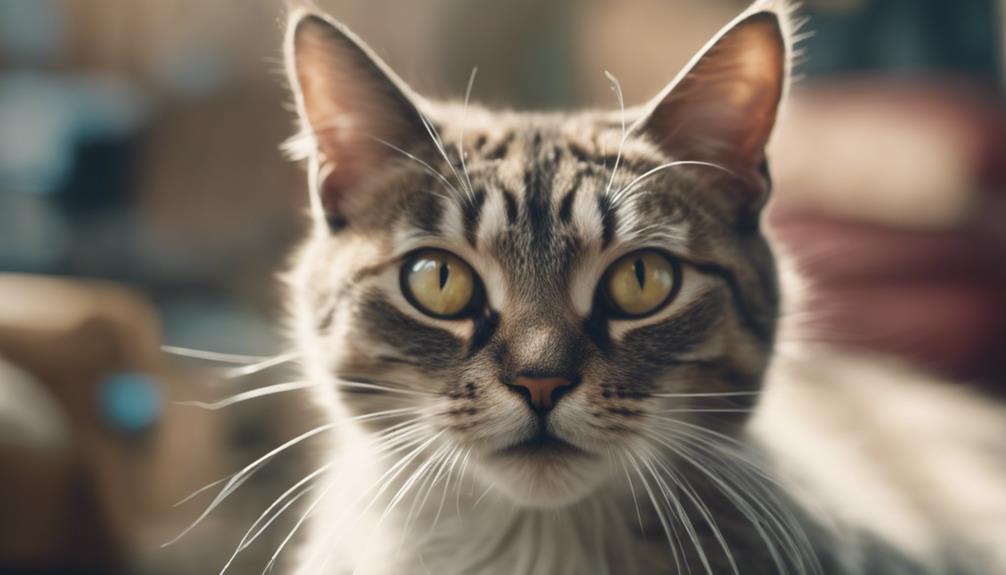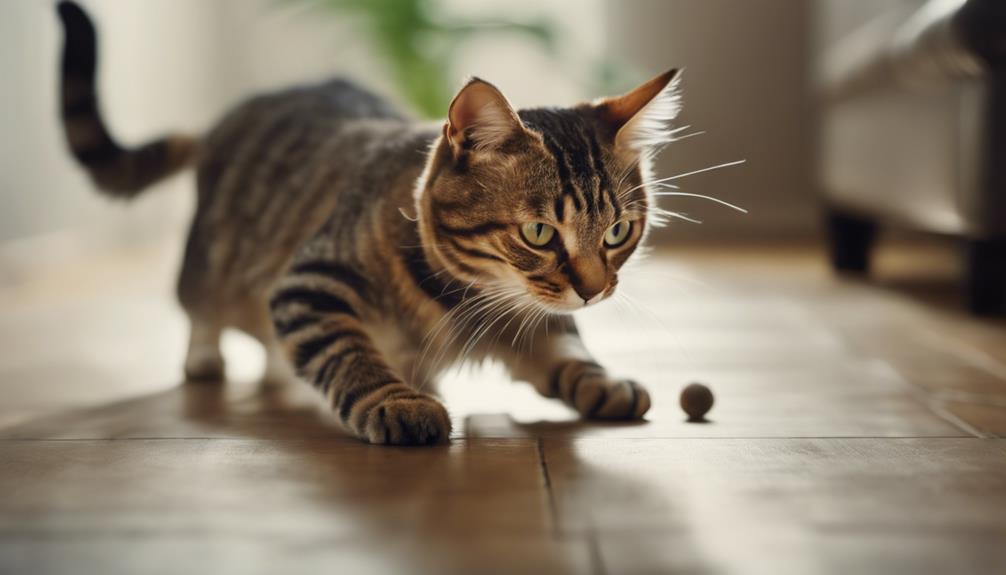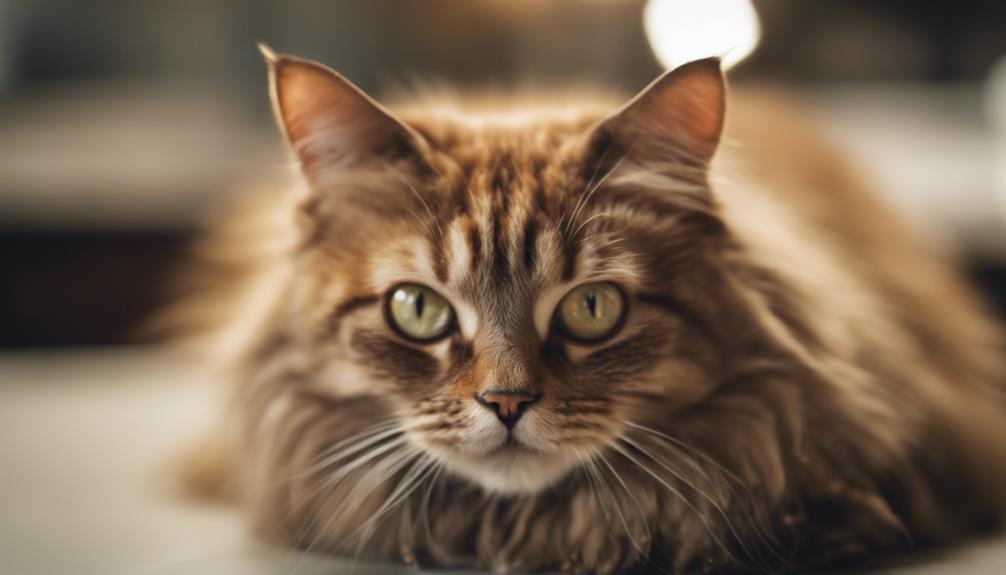Coincidentally, many cat owners have experienced the sharp sting of a cat bite at some point. Understanding the underlying reasons behind this behavior is key to fostering a harmonious relationship with feline companions.
From playful nibbles to more serious bites, cats communicate through their actions. By unraveling the complexities of cat biting behavior, individuals can discover effective strategies for training their furry friends.
What insights lie ahead for those seeking to navigate the world of feline communication and behavior modification?
Key Takeaways
- Understand reasons for biting: playfulness, pain, fear, stress, frustration, and predatory instincts.
- Redirect play to toys early: prevent inappropriate interactions and establish boundaries.
- Address fear, stress, and pain promptly: recognize triggers and respond to avoid biting.
- Manage predatory instincts: redirect hunting behaviors to toys, provide outlets for play, and recognize signs.
Understanding Cat Biting Behavior
Understanding a cat's biting behavior is crucial for addressing and managing potential triggers that may lead to aggression. Cats bite for various reasons, such as playfulness, pain, illness, fear, stress, frustration, or predatory instincts. This behavior typically starts in kittens around 12 weeks old as they develop hunting and communication skills.
Ignoring warning signs of fear, stress, or pain can trigger biting episodes. Frustration from ineffective communication can also lead to biting. Cats possess natural predatory instincts that may manifest in biting behaviors.
Setting Boundaries for Playtime
To establish healthy play interactions with your cat, it's essential to set clear boundaries for playtime that encourage appropriate behavior and prevent biting incidents.
- Engage in Consistent Play Sessions: Regular playtimes help establish a routine for your cat.
- Use Interactive Toys: Toys like feather wands or laser pointers can keep your cat engaged without using your hands.
- Avoid Rough Play: Discourage aggressive play behaviors to prevent biting tendencies.
- Provide Positive Reinforcement: Reward good behavior with treats or praise to reinforce appropriate play.
- Monitor Play Intensity: Watch for signs of overstimulation and give your cat breaks to prevent aggressive behavior.
Recognizing Stress Triggers

During periods of stress, cats may exhibit various behavioral cues that signal their discomfort and potential for biting. Signs of stress in cats include dilated pupils, flattened ears, excessive grooming, hiding, or aggression. Cats can become stressed due to changes in their environment, such as moving to a new home, introducing a new pet, loud noises, or disruptions in their routine.
Additionally, medical issues like dental problems or infections can also lead to stress and subsequent biting behavior. It's crucial for cat owners to pay attention to these stress triggers and provide a calm and secure environment for their feline friends to prevent biting incidents.
Recognizing and addressing stressors promptly can help alleviate your cat's discomfort and reduce the likelihood of aggressive behavior.
Managing Feline Frustration
After recognizing stress triggers in cats, addressing feline frustration is essential to prevent biting behavior and maintain a harmonious relationship with your pet. Here are some tips to help manage feline frustration:
- Providing interactive toys for mental stimulation.
- Creating safe spaces where your cat can retreat.
- Establishing a consistent routine to reduce uncertainty.
- Engaging in regular play sessions to release excess energy.
- Offering scratching posts or pads to fulfill natural instincts.
Redirecting Predatory Instincts

Redirecting a cat's predatory instincts can be achieved by providing appropriate toys and outlets for their natural hunting behaviors. Interactive toys that mimic prey movements, such as feather wands or laser pointers, can engage a cat's hunting instincts in a safe and controlled manner. Additionally, puzzle feeders or treat-dispensing toys can simulate the challenge of catching and eating prey, satisfying their predatory needs. By offering these alternatives, cats can redirect their energy towards constructive play rather than resorting to biting behaviors out of frustration or unfulfilled instincts.
| Toys for Predatory Instincts | Description |
|---|---|
| Feather Wands | Mimics bird-like movements to engage hunting instincts. |
| Treat-Dispensing Toys | Provides mental stimulation and simulates catching prey. |
Preventing Overstimulation
To prevent overstimulation in cats, it's crucial to recognize and respond to their body language cues indicating an increase in arousal levels. Cats exhibit subtle signs when they're reaching their limit and need a break. Here are some key points to help you prevent overstimulation and avoid potential biting incidents:
- Watch for tail twitching or lashing.
- Pay attention to flattened ears or dilated pupils.
- Notice if the cat's body becomes tense or rigid.
- Look for increased vocalization or excessive grooming.
- Provide a calm and quiet environment to help your cat relax and unwind.
Identifying Signs of Illness

If a cat displays sudden changes in behavior or uncharacteristic aggression, it may indicate underlying illness. Cats are masters at masking discomfort, making it crucial to be vigilant for subtle signs of sickness.
Watch for alterations in eating habits, litter box usage, grooming routines, energy levels, or vocalization patterns. Unexplained weight loss, lethargy, vomiting, diarrhea, or respiratory issues could also point to health issues. Additionally, changes in coat texture, lumps, bumps, or injuries warrant immediate attention.
Regular veterinary check-ups can help catch illnesses early. Being attuned to your cat's normal behaviors and promptly addressing any deviations can aid in early detection and treatment of potential health concerns.
Adjusting Interactions Appropriately
When interacting with a cat, be attentive to their body language and adjust your approach accordingly to prevent biting behaviors. Understanding the subtle cues cats give can help foster a positive interaction.
Here are some key tips to adjust your interactions appropriately:
- Observe the cat's tail movement and ear position for clues on their mood.
- Avoid sudden movements or loud noises that may startle the cat.
- Offer treats or toys when the cat shows signs of aggression to redirect their focus.
- Provide a safe space for the cat to retreat to if they seem overwhelmed.
- Respect the cat's boundaries and give them space when needed to avoid triggering defensive behaviors.
Conclusion
In conclusion, training a cat not to bite requires patience, consistency, and a keen understanding of feline behavior. Just like sculptors shaping clay, cat owners must mold their interactions with their pets to create a harmonious bond.
By setting boundaries, recognizing triggers, and redirecting instincts, individuals can sculpt a safe and fulfilling relationship with their feline companions. Remember, like clay in the hands of a skilled artist, with care and guidance, a cat's behavior can be shaped into a masterpiece of love and companionship.




